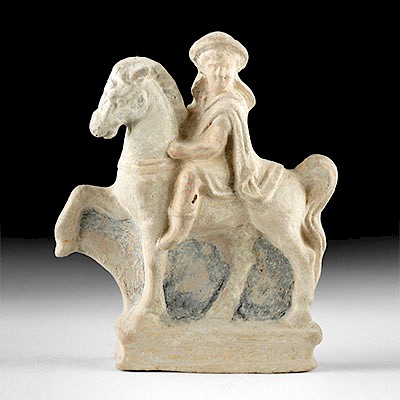Large / Impressive 19th C. Mexican Painted Wood Cross
Lot 157
About Seller
Artemis Fine Arts
686 S Taylor Ave, Ste 106
Louisville, CO 80027
United States
Selling antiquities, ancient and ethnographic art online since 1993, Artemis Gallery specializes in Classical Antiquities (Egyptian, Greek, Roman, Near Eastern), Asian, Pre-Columbian, African / Tribal / Oceanographic art. Our extensive inventory includes pottery, stone, metal, wood, glass and textil...Read more
Estimate:
$3,200 - $4,800
Absentee vs Live bid
Two ways to bid:
- Leave a max absentee bid and the platform will bid on your behalf up to your maximum bid during the live auction.
- Bid live during the auction and your bids will be submitted real-time to the auctioneer.
Bid Increments
| Price | Bid Increment |
|---|---|
| $0 | $25 |
| $300 | $50 |
| $1,000 | $100 |
| $2,000 | $250 |
| $5,000 | $500 |
| $10,000 | $1,000 |
| $20,000 | $2,500 |
| $50,000 | $5,000 |
| $100,000 | $10,000 |
| $200,000 | $20,000 |
About Auction
By Artemis Fine Arts
May 9, 2019
Set Reminder
2019-05-09 10:00:00
2019-05-09 10:00:00
America/New_York
Bidsquare
Bidsquare : Ancient | Asian | Ethnographic
https://www.bidsquare.com/auctions/artemis-gallery/ancient-asian-ethnographic-4110
Featuring classical antiquities, ancient and ethnographic art from cultures encompassing the globe. All legally acquired, legal to sell. Satisfaction guaranteed. Convenient in-house shipping. Artemis Fine Arts info@artemisgallery.com
Featuring classical antiquities, ancient and ethnographic art from cultures encompassing the globe. All legally acquired, legal to sell. Satisfaction guaranteed. Convenient in-house shipping. Artemis Fine Arts info@artemisgallery.com
- Lot Description
New World, Mexico, ca. 19th century CE. A tremendous wooden cross, handmade and constructed from multiple pieces of wood, painted by a pious folk artist. The cross is painted green, with black-outlined red and yellow motifs around a central figure of Christ, his head dripping blood from the crown of thorns. On either side of him are ladders, spears, and pikes, representing his placement on the cross and the weapons of the Roman guards. Above him is the Seamless Robe of Jesus. Above that is a wooden plaque reading "INRI," meaning, "Jesus of Nazareth, King of the Jews," the sign nailed above Christ's head as He was dying. Below Christ, on the long arm of the cross, is a stylized heart dripping into a goblet, symbolizing the Holy Grail, and below that, a cock on a column. Size: 11" L x 21.3" W x 51.4" H (27.9 cm x 54.1 cm x 130.6 cm)
The latter is a very ancient Christian symbol, representing the cock whose crow signaled that St. Peter had thrice denied knowing Christ. Although on its face this seems to be a condemnation of Peter's actions, it is meant to represent that a person could redeem himself even after committing one of the worst sins imaginable. Early artists, attempting to recreate the Biblical scene, seem to have struggled with where to place the cock - in a tree? on the ground? in an architectural feature? Slowly, through Roman and later Italian funerary sarcophagi carving, artists established a visual shorthand for the scene where the cock stands atop a Roman-style column. The folk artist who created this cross drew on that nearly-two-millennia-old tradition to paint this scene.
Provenance: private Omer Claiborne collection, Santa Fe, New Mexico, USA; acquired over the last 40 years
All items legal to buy/sell under U.S. Statute covering cultural patrimony Code 2600, CHAPTER 14, and are guaranteed to be as described or your money back.
A Certificate of Authenticity will accompany all winning bids.
We ship worldwide and handle all shipping in-house for your convenience.
#129228Inactive insect damage on the back, with losses to paint as shown, especially on the back and the base. Colors and artwork are generally nicely preserved, with a good patina from age and handling on exposed wood surfaces, especially the INRI sign at the top.Condition
- Shipping Info
-
All shipping is handled in-house for your convenience. Your invoice from Artemis Gallery will include shipping calculation instructions. If in doubt, please inquire BEFORE bidding for estimated shipping costs for individual items.
-
- Buyer's Premium



 EUR
EUR CAD
CAD AUD
AUD GBP
GBP MXN
MXN HKD
HKD CNY
CNY MYR
MYR SEK
SEK SGD
SGD CHF
CHF THB
THB


















